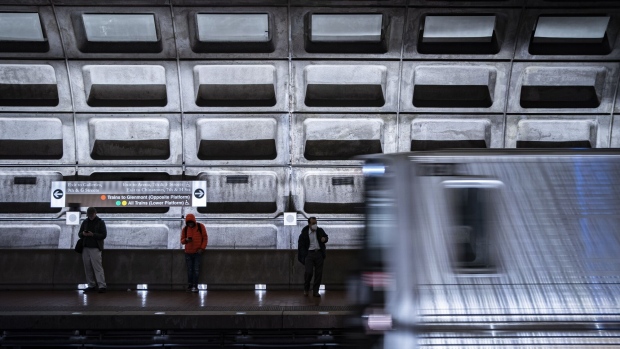Dec 12, 2023
DC Transit Sees Service Cuts, Thousands of Layoffs During Deficit
, Bloomberg News

(Bloomberg) -- Subway riders in Washington are facing a tougher commute next year with the agency that runs the public transit system serving the nation’s capital forecasting thousands of layoffs and service cuts to plug a $750 million budget hole.
That’s the future the Washington Metropolitan Area Transit Authority will present in an updated financial plan to its board on Thursday, according to a Monday briefing with reporters. WMATA, which serves more than 600,000 daily customers, runs the metro and buses in the District of Columbia and the surrounding areas in Maryland and Virginia.
The agency says it will have to cut its 12,000 person work force by nearly 20% or about 2,300 people, a reduction that would lead to dirtier stations, a drop in safety and security measures and reliability issues across its network. On top of the staffing cuts, WMATA is considering slashing service, including eliminating or reducing service on 108 of its 135 bus lines. The rail system, which currently runs until midnight most days, will cease operations at 10 p.m. impacting as much as six million customer trips, the agency said.
It’s “no secret we have massive budget challenges,” Randy Clarke, the agency’s general manager and chief executive officer said during a briefing Monday. One slide displayed during the presentation described the grim outlook: “Balancing Budget with Severe Service Cuts Would Make Metro Unrecognizable.”
He said that a “healthy” metro is needed to support the workings of the DC, Maryland and Virgina area, known as the DMV.
The prospect illustrates the struggles public transit systems are facing across the country as office workers largely embrace a hybrid schedule. In DC, where less than half of employees have returned to the office, the struggles are particularly acute. Virginia Governor Glenn Youngkin last week urged President Joe Biden to mandate a full return to office policy for federal employees to help boost revenue for WMATA.
The agency is expecting a $750 million shortfall starting next summer that is anticipated to balloon to $1.2 billion by fiscal year 2035, according to projections. To close the upcoming budget hole for the fiscal year that starts in July, the agency plans on transferring $193 million from preventative maintenance to fund operations. After identifying cost cutting and internal efficiency measures, the budget will be balanced through roughly $433 million of service reductions, layoffs and fare hikes.
Read more: US Subways and Buses Risk Service Cuts as Federal Money Ends
Clarke said that there is a sense of urgency in the region to find a funding solution and called on the federal government to allocate more dollars to help with operations.
The agency has $17 billion of capital needs over the next six years, but will only be able to satisfy about two-thirds of that. Some of the projects that will be impacted by the delays include transitioning to electric buses, adding new stations to various rail lines and building a new bus garage.
©2023 Bloomberg L.P.






